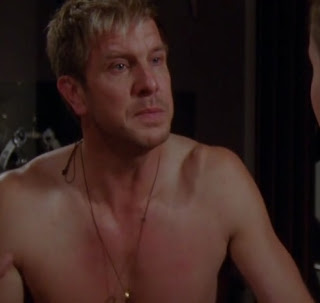 While browsing on Pixiv, I came across a lot of fan art (most too graphic for this site) starring a muscular blond guy with a baseball cap reading "Kill."
While browsing on Pixiv, I came across a lot of fan art (most too graphic for this site) starring a muscular blond guy with a baseball cap reading "Kill."
Sometimes he was making out with, rescuing, or being rescued by a guy dressed all in white, with Japanese writing on his baseball cap (all fan art copyrighted by the artists).
A little more research, and I found out that his name was "Killer T-Cell."
And a manga series called Cells at Work (2015-), which has been adapted into an anime (now playing on Netflix).
She gets lost on the way to the lungs, and ends up in the spleen, and then in a lymph node.
When an evil bacterium attacks, she is saved by white blood cell U-1146 (Billy Kametz), a muscular all-white teenager. They have a history: he saved her from an evil bacterium long ago, when he was just a student in White Blood Cell School.
Future episodes introduce many other types of cells, including the cocky, aggressive Killer T-Cell (Robbie Daymond), who is responsible for killing cancerous or otherwise damaged cells.
The plots involve conflicts between various types of cells:
When Killer T-Cell gets into an argument with his commanding officer, Helper T-Cell (Ray Chase), Dentritic T-Cell reveals a photo album indicating that they were close friends in White Blood Cell school. They are embarrassed, and try to destroy the album.
And responses to threats:
The body suffers from heat stroke, leading to "global warming," a depletion of fluids. and an invasion of bacillus cereus, which thrive on high temperatures. U-1146 pursues the bacillus, but is too weak from fluid depletion to fight. Then the body gets an injection of new fluid, reviving everyone.
A band of staphylococcus aureus invade the nasal cavity. They trap the white blood cells in a mesh of fibrin. Mysterious hazmat-suited monocytes come to the rescue. Later the monocytes take off their hazmat suits, revealing that they are really macrophages in disguise. Whoa, plot twist!
I have so many questions.
1. If cells are anthropomorphic beings, then their bodies must also be full of anthropomorphic cells, and so on, and so on, all the way down ad infinitium.
2. They know that they are in "the body," but do they realize that it's a sentient being? Do they think it's the entire universe?
3. They eat (glucose from food kiosks), and they have day and night, but do they have private lives? Apartments? Recreation? Do they sleep? Date? Read philosophical tracts about the nature of the universe?
4. Why is it so barbaric? "Kill them! Kill every one of them!" may be ok for pathogens, but it's inappropriate for human-looking enemy troops who are just following orders. It's like in the Bible where the God tells the Israelites to take over a town and kill everyone, even the children and animals.
4. Why is it so barbaric? "Kill them! Kill every one of them!" may be ok for pathogens, but it's inappropriate for human-looking enemy troops who are just following orders. It's like in the Bible where the God tells the Israelites to take over a town and kill everyone, even the children and animals.
5. There's a lot of very technical information. Eosonophilia are white blood cells responsible for fighting multicellular parasites, but not bacteria or viruses. Basphilia are white blood cells responsible for histamine, which produces the inflammatory reaction to infections. Is this entertainment or a physiology textbook?
This is all so bizarre that I forgot to check for gay characters or subtexts. I don't think the blood cells actually have romantic relationships, but there is plenty of fan shipping.







